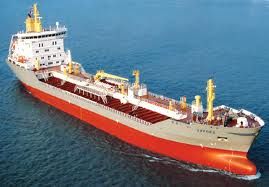
Owners of the largest oil tankers will see their earnings almost double in the second half of the year, from the first six months, on strong Chinese demand and rising
Middle East exports, a Reuters poll showed.
China, the world's second largest oil consumer, is expected to drive global demand to a record 89.3 million barrels per day this year with the strongest period seen in the third and fourth quarters, according to the International Energy Agency's most recent outlook report.
The surge in Chinese crude oil imports should help alleviate the global fleet's oversupply problem, which has caused a severe downturn in the freight markets for more than a year.
'Going forward, the expectations is that China will return to year-on-year oil demand growth rates near 10 per cent,' said George Los, analyst with Charles R Weber.
China's oil demand grew about 7 per cent in the second quarter from a year ago and is expected to rise almost 9 per cent in the third quarter, according to IEA forecasts.
'The possibility remains strong for a thinning of Middle East VLCC tonnage from the start of the fourth quarter, allowing for modest gains across the sector,' he said.
All but one of the 10 analysts and shipbrokers surveyed over the last two weeks agreed that rates for Very Large Crude Carriers (VLCCs), the largest crude oil tankers, would rise sharply in the last six months of this year compared to the first half of 2011.
The median of the poll showed VLCC earnings on the spot market, or time charter equivalent rate, would average US$26,250 per day in H2 2011, up 92 per cent from US$13,654 in H1 - the lowest half year average since the Baltic Exchange began its TCE reports three years ago.
Earnings for a VLCC on the benchmark Middle East to Japan route on Monday fell to an eight-week low of US$2,749 per day.
A typical VLCC can transport as much as two million barrels of crude oil.
Suezmax tankers were expected to rise 15 per cent to US$19,050 per day, while smaller sized Aframaxes were seen up 36 per cent at US$12,835.
For products, earnings were seen climbing for the two largest categories of clean tankers, but were likely to fall for medium range vessels, the poll showed.
'The second half will turn out generally better than H1 2011 mainly on seasonal factors,' said Nigel Prentis, an analyst with HSBC.
'A seasonal demand rise in Q3 and Q4 should see more barrels on the water. Yet, it is unclear if Saudi Arabia, Kuwait and the United Arab Emirates can supply extra barrels of the light sweet crude that is needed,' he added.
Saudi Arabia, the world's top oil exporter, has pledged to meet rising global demand in the third quarter by tapping into its spare capacity after Opec failed to sanction a collective output increase.
Anticipating a time lag before Saudi's extra barrels arrive to the market, the IEA last month tapped into its own strategic petroleum reserves for only the third time in history to fill the supply gap.
IEA's surprise action has pressured freight rates as industrialised nations were likely to rely less on imports following the release of up to 60 million barrels from their stockpiles.
The market, however, could find some support if oil traders begin to use VLCCs to store oil at sea, a scenario that could become economically viable if prompt crude prices become cheaper than prices for longer term delivery.
Source: Reuters
We use cookies to improve your experience. By continuing to use our site, you accept our Cookies, Privacy Policy,Terms and Conditions. Close X